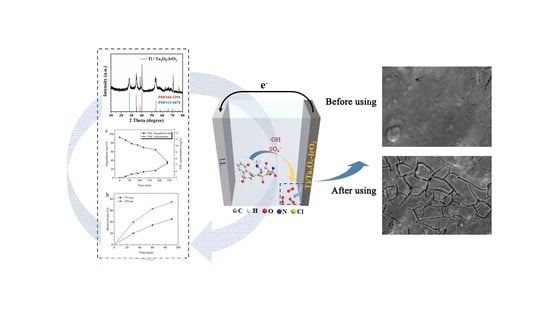Electrochemical Degradation of Tetracycline Using a Ti/Ta2O5-IrO2 Anode: Performance, Kinetics, and Degradation Mechanism
Abstract
:1. Introduction
2. Materials and Methods
2.1. Experimental Materials
2.2. Experimental Methods
2.3. Analytical Methods
3. Results
3.1. Electrode Morphology and Electrochemical Analysis
3.2. Factors Influencing TC Electrochemical Oxidation
3.3. Electrochemical Oxidation Mechanism of TC
3.3.1. UV–Vis Adsorption Spectra
3.3.2. Detection of Hydroxyl Radicals
3.3.3. TOC
3.3.4. Identification of Intermediates and the Proposed Degradation Pathways
4. Conclusions
Author Contributions
Funding
Conflicts of Interest
References
- Van Boeckel, T.P.; Glennon, E.E.; Chen, D.; Gilbert, M.; Robinson, T.P.; Grenfell, B.T.; Levin, S.A.; Bonhoeffer, S.; Laxminarayan, R. Reducing antimicrobial use in food animals Consider user fees and regulatory caps on veterinary use. Science 2017, 357, 1350–1352. [Google Scholar] [CrossRef] [PubMed] [Green Version]
- Sarmah, A.K.; Meyer, M.T.; Boxall, A.B. A global perspective on the use, sales, exposure pathways, occurrence, fate and effects of veterinary antibiotics (VAs) in the environment. Chemosphere 2006, 65, 725–759. [Google Scholar] [CrossRef]
- Wei, R.; Ge, F.; Zhang, L.; Hou, X.; Cao, Y.; Gong, L.; Chen, M.; Wang, R.; Bao, E. Occurrence of 13 veterinary drugs in animal manure-amended soils in Eastern China. Chemosphere 2016, 144, 2377–2383. [Google Scholar] [CrossRef] [PubMed]
- Oberoi, A.S.; Jia, Y.; Zhang, H.; Khanal, S.K.; Lu, H. Insights into the Fate and Removal of Antibiotics in Engineered Biological Treatment Systems: A Critical Review. Environ. Sci. Technol. 2019, 53, 7234–7264. [Google Scholar] [CrossRef] [PubMed]
- Park, J.; Yamashita, N.; Park, C.; Shimono, T.; Takeuchi, D.M.; Tanaka, H. Removal characteristics of pharmaceuticals and personal care products: Comparison between membrane bioreactor and various biological treatment processes. Chemosphere 2017, 179, 347–358. [Google Scholar] [CrossRef]
- Li, N.; Zhang, X.; Wu, W.; Zhao, X. Occurrence, seasonal variation and risk assessment of antibiotics in the reservoirs in North China. Chemosphere 2014, 111, 327–335. [Google Scholar] [CrossRef]
- Shi, X.; Zhou, J.; Zhao, H.; Hou, L.; Yang, Y. Application of passive sampling in assessing the occurrence and risk of antibiotics and endocrine disrupting chemicals in the Yangtze Estuary, China. Chemosphere 2014, 111, 344–351. [Google Scholar] [CrossRef]
- Li, X.; Liu, C.; Chen, Y.; Huang, H.; Ren, T. Antibiotic residues in liquid manure from swine feedlot and their effects on nearby groundwater in regions of North China. Environ. Sci. Pollut. Res. 2018, 25, 11565–11575. [Google Scholar] [CrossRef]
- Kang, Y.; Li, Q.; Mei, L.; Zhao, H.; Bai, Y.; Shen, M.; Hu, J. Tetracycline resistance genes are more prevalent in wet soils than in dry soils. Ecotoxicol. Environ. Saf. 2018, 156, 337–343. [Google Scholar] [CrossRef]
- Shi, H.; Yang, Y.; Liu, M.; Yan, C.; Yue, H.; Zhou, J. Occurrence and distribution of antibiotics in the surface sediments of the Yangtze Estuary and nearby coastal areas. Mar. Pollut. Bull. 2014, 83, 317–323. [Google Scholar] [CrossRef]
- Yuan, M.M.; Xu, H.; Yan, W. Advances in the study of electrochemical oxidation reactor for organic compounds. Environ. Eng. 2018, 7, 76–81. [Google Scholar]
- Wang, J.; Zhi, D.; Zhou, H.; He, X.; Zhang, D. Evaluating tetracycline degradation pathway and intermediate toxicity during the electrochemical oxidation over a Ti/Ti4O7 anode. Water Res. 2018, 137, 324–334. [Google Scholar] [CrossRef] [PubMed]
- Minakshi, M.; Singh, P.; Issa, T.B.; Thurgate, S.; De Marco, R. Lithium insertion into manganese dioxide electrode in MnO/Zn aqueous battery: Part III. Electrochemical behavior of MnO in aqueous lithium hydroxide electrolyte. J. Power Sources 2006, 153, 165–169. [Google Scholar] [CrossRef]
- Minakshi, M.; Singh, P.; Issa, T.B.; Thurgate, S.; De Marco, R. Lithium insertion into manganese dioxide electrode in MnO2/Zn aqueous battery: Part II. Comparison of the behavior of EMD and battery grade MnO2 in Zn|MnO2|aqueous LiOH electrolyte. J. Power Sources 2004, 138, 319–322. [Google Scholar] [CrossRef]
- Minakshi, M.; Ionescu, M. Anodic behavior of zinc in Zn-MnO2 battery using ERDA technique. Int. J. Hydrog. Energy 2010, 35, 7618–7622. [Google Scholar] [CrossRef]
- Perea, A.; Palma-Goyes, R.E.; Vazquez-Arenas, J.; Romero-Ibarra, I.; Ostos, C.; Torres-Palma, R.A. Efficient cephalexin degradation using active chlorine produced on ruthenium and iridium oxide anodes: Role of bath composition, analysis of degradation pathways and degradation extent. Sci. Total Environ. 2019, 648, 377–387. [Google Scholar] [CrossRef]
- Yang, K.; Liu, Y.; Liu, J.; Qiao, J. Preparation optimization of multilayer-structured SnO2–Sb–Ce/Ti electrode for efficient electrocatalytic oxidation of tetracycline in water. Chin. J. Chem. Eng. 2018, 26, 239–244. [Google Scholar] [CrossRef]
- Frontistis, Z.; Meriç, S. The role of operating parameters and irradiation on the electrochemical degradation of tetracycline on boron doped diamond anode in environmentally relevant matrices. J. Chem. Technol. Biotechnol. 2018, 93, 3648–3655. [Google Scholar] [CrossRef]
- Brinzila, C.I.; Pacheco, M.J.; Ciríaco, L.; Ciobanu, R.C.; Lopes, A. Electrodegradation of tetracycline on BDD anode. Chem. Eng. J. 2012, 209, 54–61. [Google Scholar] [CrossRef]
- Treviño-Reséndez, J.; Nacheva, P.M. IrO2-Ta2O5 vertical bar Ti electrodes prepared by electrodeposition from different Ir: Ta ratios for the degradation of polycyclic aromatic hydrocarbons. Electrochim. Acta 2018, 263, 353–361. [Google Scholar]
- Yan, Z.; Zhao, Y.; Zhang, Z.; Li, G.; Li, H.; Wang, J.; Feng, Z.; Tang, M.; Yuan, X.; Zhang, R.; et al. A study on the performance of IrO2-Ta2O5 coated anodes with surface treated Ti substrates. Electrochim. Acta 2015, 157, 345–350. [Google Scholar] [CrossRef]
- Xu, L.; Xin, Y.; Wang, J. A comparative study on IrO2–Ta2O5 coated titanium electrodes prepared with different methods. Electrochim. Acta 2009, 54, 1820–1825. [Google Scholar] [CrossRef]
- Yi, Z.; Kangning, C.; Wei, W.; Wang, J.; Lee, S. Effect of IrO2 loading on RuO2–IrO2–TiO2 anodes: A study of microstructure and working life for the chlorine evolution reaction. Ceram. Int. 2007, 33, 1087–1091. [Google Scholar] [CrossRef]
- Zhuo, Q.; Wang, J.; Niu, J.; Yang, B.; Yang, Y. Electrochemical oxidation of perfluorooctane sulfonate (PFOS) substitute by modified boron doped diamond (BDD) anodes. Chem. Eng. J. 2020, 379, 122280. [Google Scholar] [CrossRef]
- Qian, S.; Liu, S.; Jiang, Z.; Deng, D.; Tang, B.; Zhang, J. Electrochemical Degradation of Tetracycline Antibiotics Using a Ti/SnO2-Sb2O3/PbO2 Anode: Kinetics, Pathways, and Biotoxicity Change. J. Electrochem. Soc. 2019, 166, E192–E199. [Google Scholar] [CrossRef]
- Li, H.; Yu, Q.; Yang, B.; Li, Z.; Lei, L. Electrochemical treatment of artificial humidity condensate by large-scale boron doped diamond electrode. Sep. Purif. Technol. 2014, 138, 13–20. [Google Scholar] [CrossRef]
- Zhao, R.; Zhang, X.; Chen, F.; Man, X.; Jiang, W. Study on Electrochemical Degradation of Nicosulfuron by IrO2-Based DSA Electrodes: Performance, Kinetics, and Degradation Mechanism. Int. J. Environ. Res. Public Health 2019, 16, 343–347. [Google Scholar] [CrossRef] [Green Version]
- Garza-Campos, B.; Morales-Acosta, D.; Hernández-Ramírez, A.; Mar, J.L.G.; Hinojosa-Reyes, L.; Manríquez, J.; Ruiz-Ruiz, E. Air diffusion electrodes based on synthetized mesoporous carbon for application in amoxicillin degradation by electro-Fenton and solar photo electro-Fenton. Electrochim. Acta 2018, 269, 232–240. [Google Scholar] [CrossRef]
- Yao, Y.; Li, M.; Yang, Y.; Cui, L.; Guo, L. Electrochemical degradation of insecticide hexazinone with Bi-doped PbO2 electrode: Influencing factors, intermediates and degradation mechanism. Chemosphere 2019, 216, 812–822. [Google Scholar] [CrossRef]
- Wang, Y.; Zhang, H.; Chen, L. Ultrasound enhanced catalytic ozonation of tetracycline in a rectangular air-lift reactor. Catal. Today 2011, 175, 283–292. [Google Scholar] [CrossRef]
- Luo, T.; Feng, H.; Tang, L.; Lu, Y.; Tang, W.; Chen, S.; Yu, J.; Xie, Q.; Ouyang, X.; Chen, Z. Efficient degradation of tetracycline by heterogeneous electro-Fenton process using Cu-doped Fe@Fe2O3: Mechanism and degradation pathway. Chem. Eng. J. 2019, 382, 122970. [Google Scholar] [CrossRef]
- Scialdone, O.; Galia, A.; Guarisco, C.; Randazzo, S.; Filardo, G. Electrochemical incineration of oxalic acid at boron doped diamond anodes: Role of operative parameters. Electrochim. Acta 2008, 53, 2095–2108. [Google Scholar] [CrossRef]
- Wang, L.; Zhao, Y.; Fu, J. The influence of TiO2 and aeration on the kinetics of electrochemical oxidation of phenol in packed bed reactor. J. Hazard. Mater. 2008, 160, 608–613. [Google Scholar] [CrossRef] [PubMed]
- Xu, M.; Deng, J.; Cai, A.; Ma, X.; Li, J.; Li, Q.; Li, X. Comparison of UVC and UVC/persulfate processes for tetracycline removal in water. Chem. Eng. J. 2019, 384, 123320. [Google Scholar] [CrossRef]
- Wang, P.; He, Y.L.; Huang, C.H. Reactions of tetracycline antibiotics with chlorine dioxide and free chlorine. Water Res. 2011, 45, 1838–1846. [Google Scholar] [CrossRef] [PubMed]
- Ao, X.; Sun, W.; Li, S.; Yang, C.; Li, C.; Lu, Z. Degradation of tetracycline by medium pressure UV-activated peroxymonosulfate process: Influencing factors, degradation pathways, and toxicity evaluation. Chem. Eng. J. 2019, 361, 1053–1062. [Google Scholar] [CrossRef]
- Oturan, N.; Wu, J.; Zhang, H.; Sharma, V.; Oturan, M.A. Electrocatalytic destruction of the antibiotic tetracycline in aqueous medium by electrochemical advanced oxidation processes: Effect of electrode materials. Appl. Catal. B Environ. 2013, 140, 92–97. [Google Scholar] [CrossRef]
- Jager, D.; Kupka, D.; Vaclavikova, M.; Ivanicova, L.; Gallios, G. Degradation of Reactive Black 5 by electrochemical oxidation. Chemosphere 2018, 190, 405–416. [Google Scholar] [CrossRef] [PubMed]
- Cheng, C.Y.; Kelsall, G.H. Models of Hypochlorite production in electrochemical reactors with plate and porous anodes. J. Appl. Electrochem. 2007, 37, 1203–1217. [Google Scholar] [CrossRef]
- Wessels, J.M.; Ford, W.E.; Szymczak, W.; Schneider, S. The complexation of tetracycline and anhydrotetracycline with Mg2+ and Ca2+: A spectroscopic study. J. Phys. Chem. B 1998, 102, 9323–9331. [Google Scholar] [CrossRef]
- Wang, Y.; Zhang, H.; Zhang, J.; Lu, C.; Huang, Q.; Wu, J.; Liu, F. Degradation of tetracycline in aqueous media by ozonation in an internal loop-lift reactor. J. Hazard Mater 2011, 192, 35–43. [Google Scholar] [CrossRef]
- Wang, H.; Chen, T.; Chen, D.; Zou, X.; Li, M.; Huang, F.; Sun, F.; Wang, C.; Shu, D.; Liu, H. Sulfurized oolitic hematite as a heterogeneous Fenton-like catalyst for tetracycline antibiotic degradation. Appl. Catal. B Environ. 2020, 260, 118203. [Google Scholar] [CrossRef]
- Dong, G.; Huang, L.; Wu, X.; Wang, C.; Liu, Y.; Liu, G.; Wang, L.; Liu, X.; Xia, H. Effect and mechanism analysis of MnO2 on permeable reactive barrier (PRB) system for the removal of tetracycline. Chemosphere 2018, 193, 702–710. [Google Scholar] [CrossRef] [PubMed]
- Clifton, C.L.; Huie, R.E. Rate constants for hydrogen abstraction reactions of the sulfate radical, SO4 Alcohols. Int. J. Chem. Kinet. 1989, 21, 677–687. [Google Scholar] [CrossRef]
- Degradation of the antibiotic oxacillin in water by anodic oxidation with Ti/IrO2 anodes: Evaluation of degradation routes, organic by-products and effects of water matrix components. Chem. Eng. J. 2015, 279, 103–114. [CrossRef]
- Panizza, M.; Martinez-Huitle, C.A. Role of electrode materials for the anodic oxidation of a real landfill leachate - Comparison between Ti-Ru-Sn ternary oxide, PbO2 and boron-doped diamond anode. Chemosphere 2013, 90, 1455–1460. [Google Scholar] [CrossRef] [PubMed]
- Dalmázio, I.; Almeida, M.O.; Augusti, R.; Alves, T.M.A. Monitoring the degradation of tetracycline by ozone in aqueous medium via atmospheric pressure ionization mass spectrometry. J. Am. Soc. Mass Spectrom. 2007, 18, 679–687. [Google Scholar] [CrossRef] [Green Version]
- Chen, W.-R.; Huang, C.-H. Transformation kinetics and pathways of tetracycline antibiotics with manganese oxide. Environ. Pollut. 2011, 159, 1092–1100. [Google Scholar] [CrossRef]
- Chen, Y.-Y.; Ma, Y.-L.; Yang, J.; Wang, L.-Q.; Lv, J.-M.; Ren, C.-J. Aqueous tetracycline degradation by H2O2 alone: Removal and transformation pathway. Chem. Eng. J. 2017, 307, 15–23. [Google Scholar] [CrossRef]
- Khan, M.H.; Bae, H.; Jung, J.-Y. Tetracycline degradation by ozonation in the aqueous phase: Proposed degradation intermediates and pathway. J. Hazard. Mater. 2010, 181, 659–665. [Google Scholar] [CrossRef] [PubMed]
- Yang, S.; Liu, Y.; Shen, C.; Li, F.; Yang, B.; Huang, M.; Yang, M.; Wang, Z.; Sand, W. Rapid decontamination of tetracycline hydrolysis product using electrochemical CNT filter: Mechanism, impacting factors and pathways. Chemosphere 2020, 244, 125525. [Google Scholar] [CrossRef] [PubMed]
- Zhang, Y.; Shi, J.; Xu, Z.; Chen, Y.; Song, D. Degradation of tetracycline in a schorl/H2O2 system: Proposed mechanism and intermediates. Chemosphere 2018, 202, 661–668. [Google Scholar] [CrossRef]
- Adams, B.; Tian, M.; Chen, A. Design and electrochemical study of SnO2 based mixed oxide electrodes. Electrochim. Acta 2009, 54, 1491–1498. [Google Scholar] [CrossRef]
- Jeong, J.; Song, W.; Cooper, W.J.; Jung, J.; Greaves, J. Degradation of tetracycline antibiotics: Mechanisms and kinetic studies for advanced oxidation/reduction processes. Chemosphere 2010, 78, 533–540. [Google Scholar] [CrossRef] [PubMed]
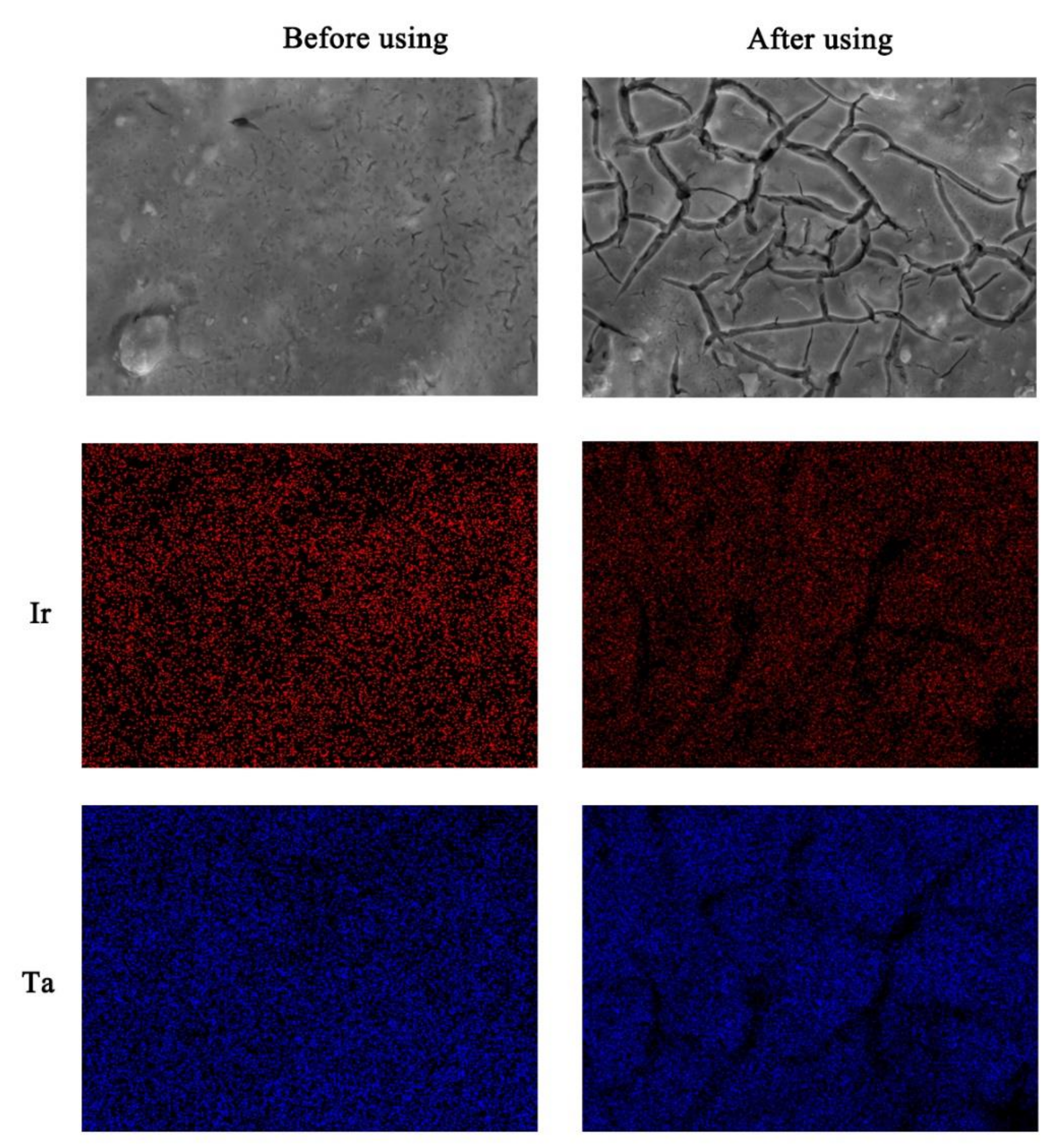
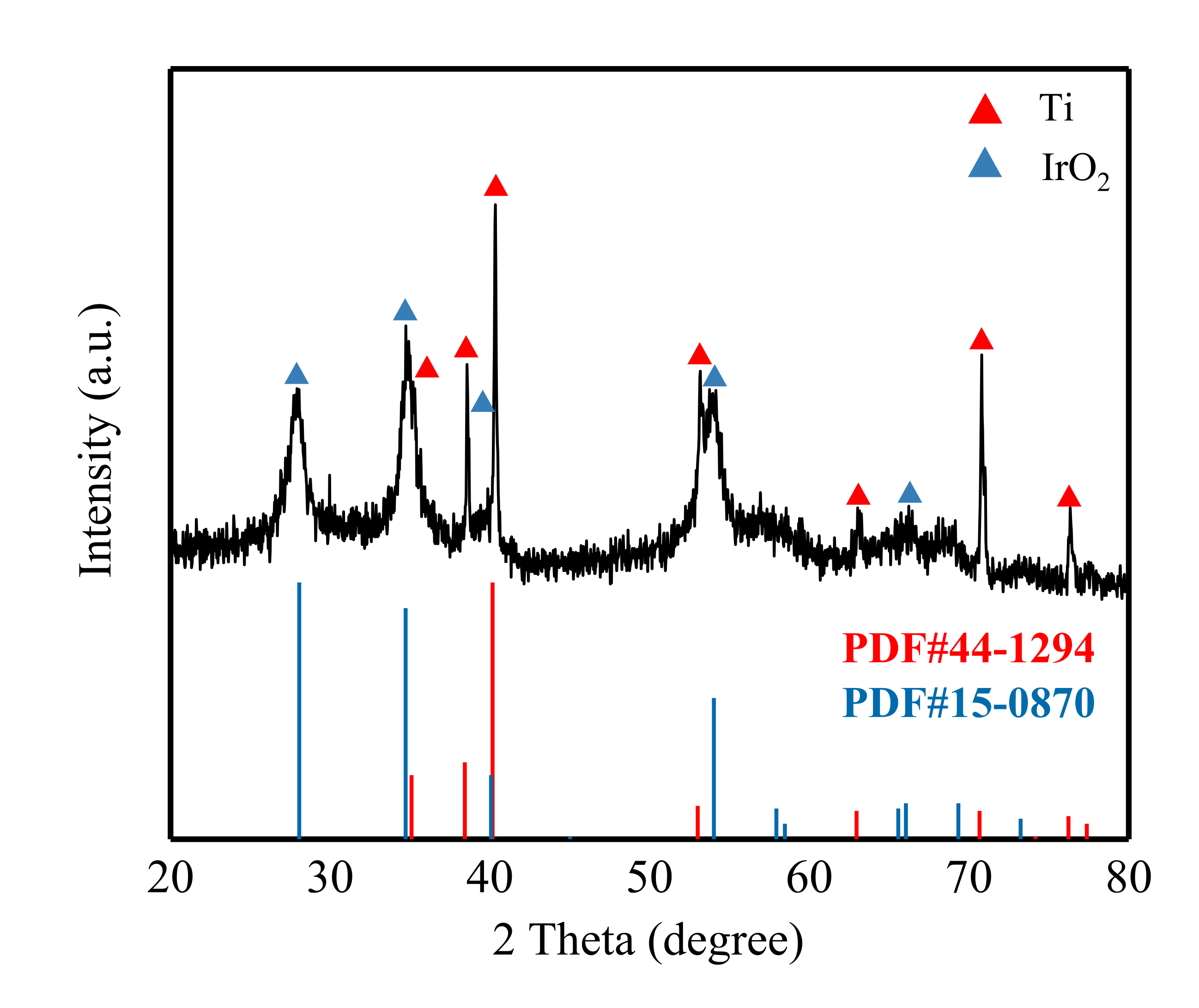

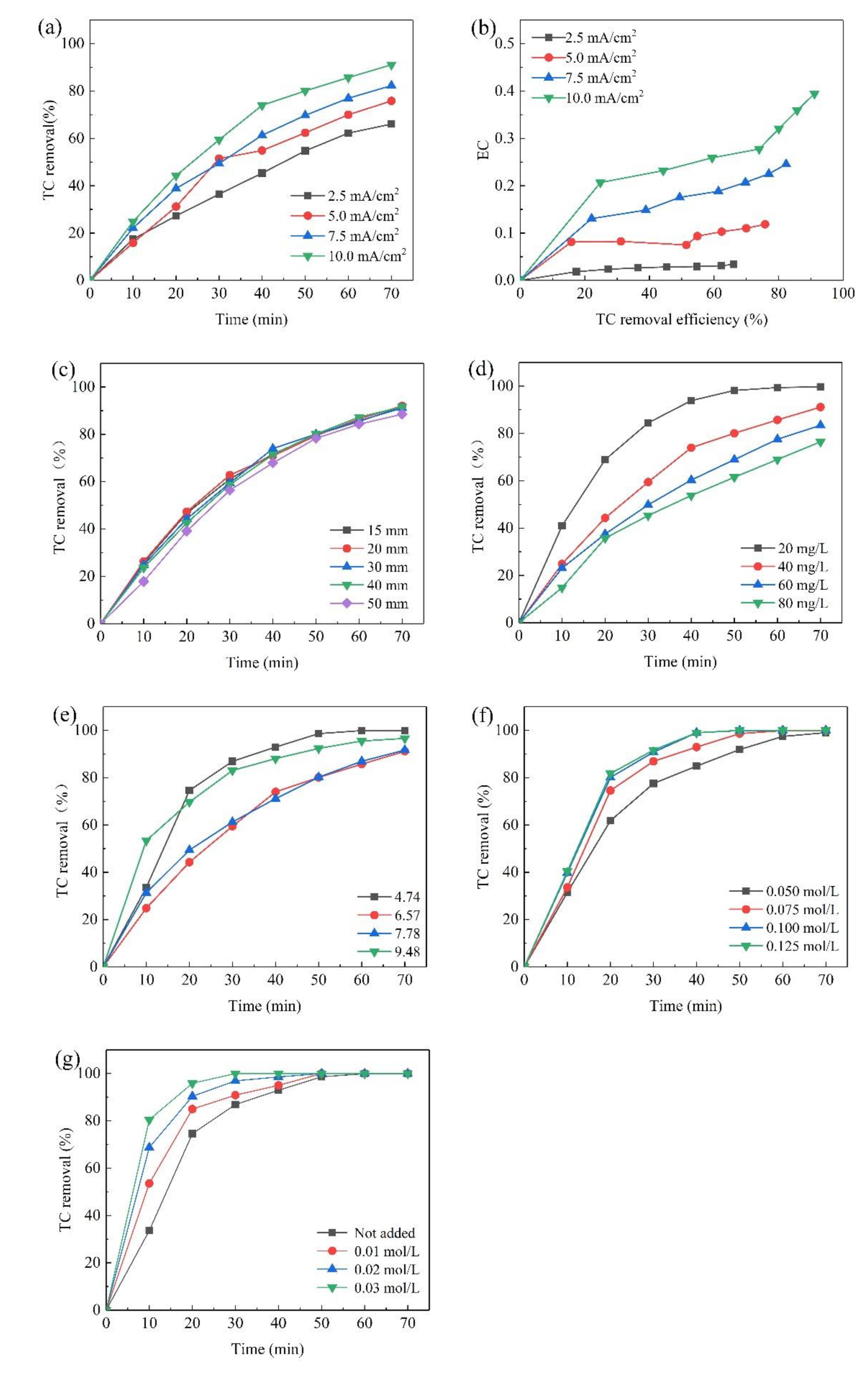
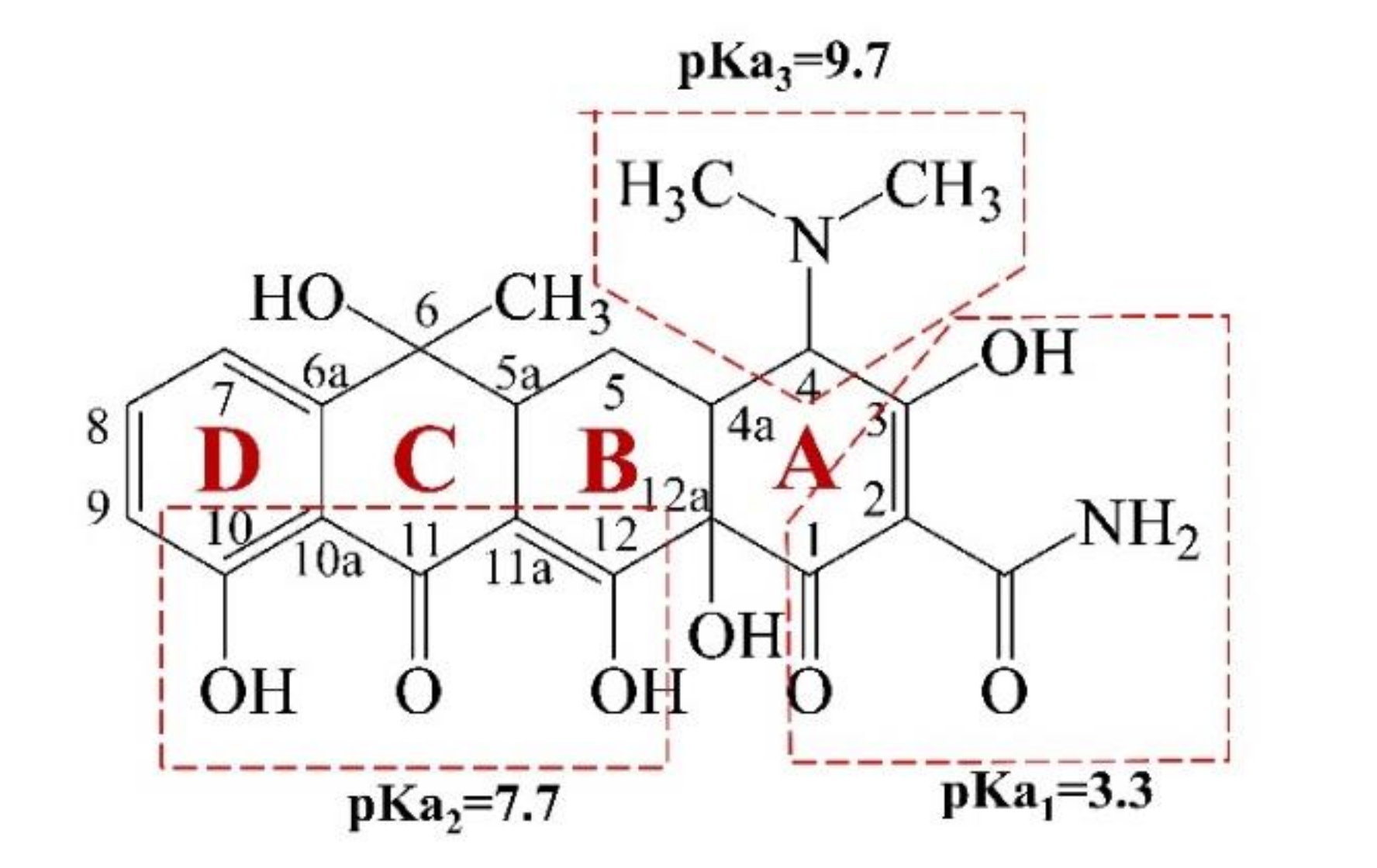
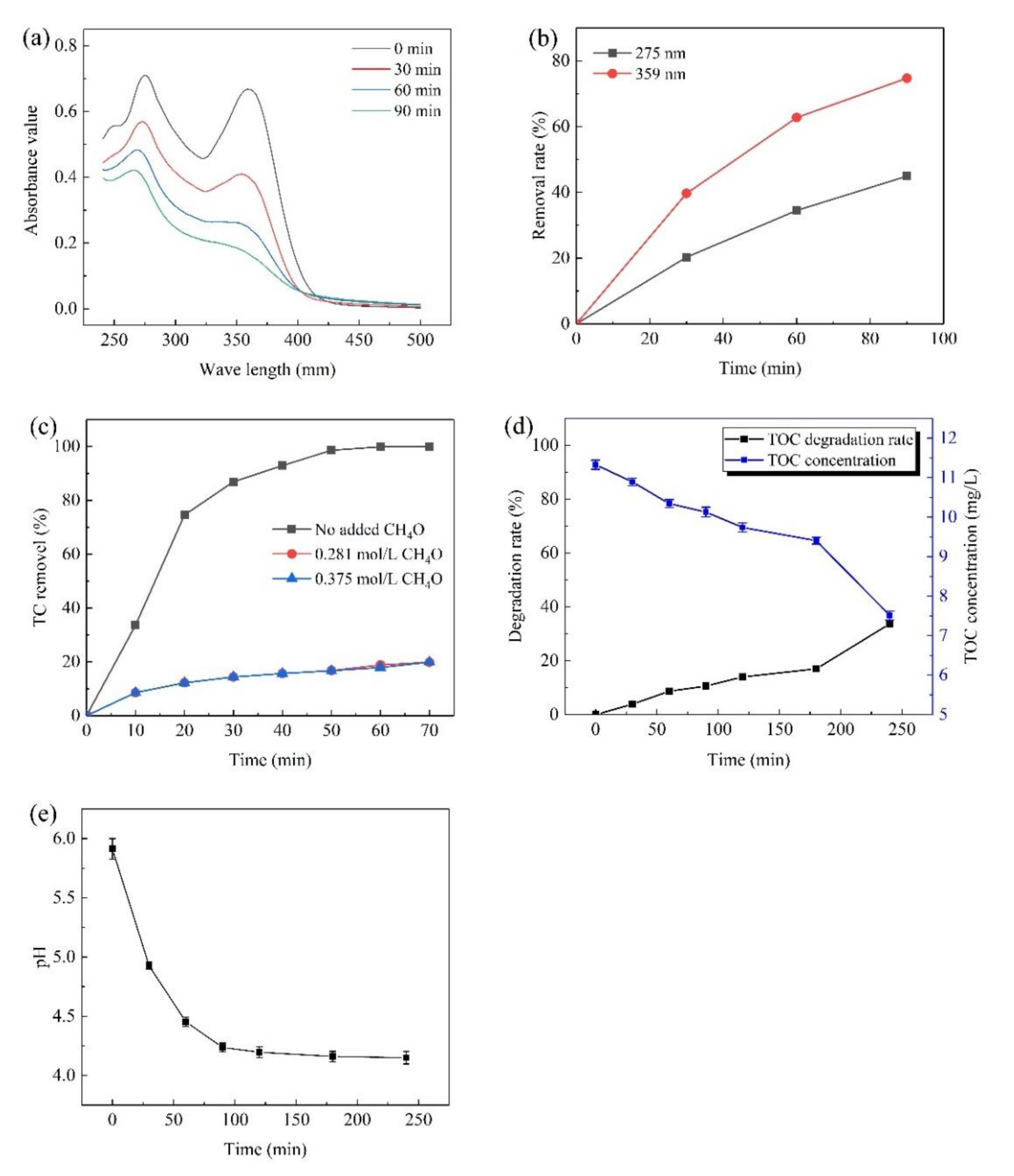

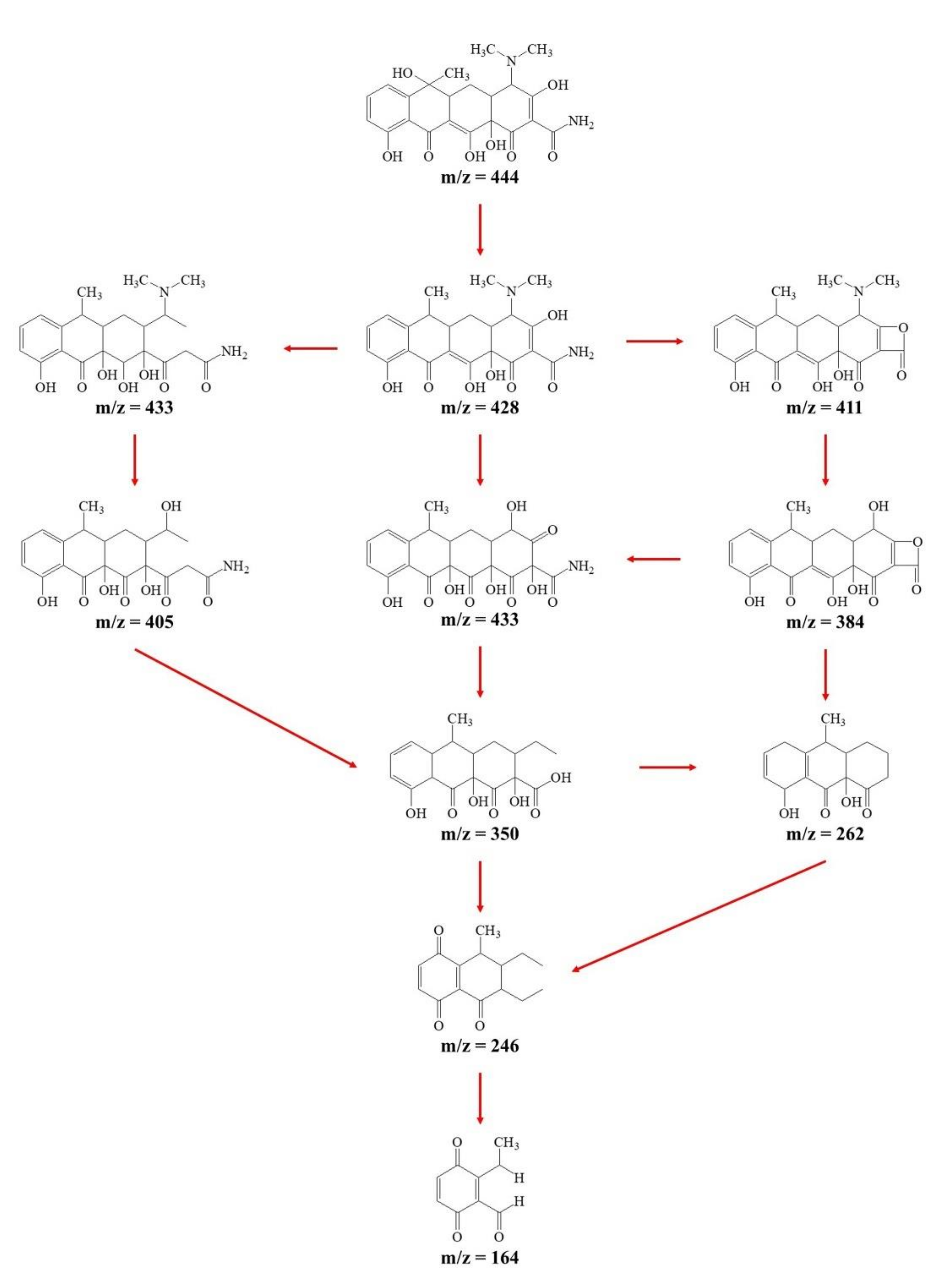
| Parameters | Degradation Efficiency (%) | Rate Constants (ka, min−1) | R2 | |
|---|---|---|---|---|
| Current density (mA/cm2) | 2.5 | 66.08 | 0.01554 | 0.996 |
| 5 | 75.84 | 0.02022 | 0.989 | |
| 7.5 | 82.33 | 0.02453 | 0.998 | |
| 10 | 91.12 | 0.03426 | 0.995 | |
| Electrode spacing (mm) | 15 | 91.59 | 0.03420 | 0.992 |
| 20 | 92.02 | 0.03484 | 0.989 | |
| 30 | 91.12 | 0.03426 | 0.995 | |
| 40 | 91.62 | 0.03456 | 0.992 | |
| 50 | 88.49 | 0.03191 | 0.995 | |
| Initial TC concentration (mg/L) | 20 | 99.69 | 0.08656 | 0.982 |
| 40 | 91.12 | 0.03426 | 0.995 | |
| 60 | 83.46 | 0.02510 | 0.993 | |
| 80 | 76.45 | 0.02009 | 0.994 | |
| Initial pH | 4.74 | 99.88 | 0.10420 | 0.936 |
| 6.57 | 91.12 | 0.03426 | 0.995 | |
| 7.78 | 91.68 | 0.03420 | 0.992 | |
| 9.48 | 96.57 | 0.04370 | 0.988 | |
| Electrolyte concentration (mol/L) | 0.050 | 84.89 | 0.04895 | 0.993 |
| 0.075 | 92.90 | 0.06914 | 0.985 | |
| 0.100 | 98.97 | 0.11025 | 0.915 | |
| 0.125 | 98.99 | 0.20280 | 0.839 | |
| Cl− concentration (mol/L) | 0 | 92.90 | 0.06914 | 0.985 |
| 0.01 | 94.99 | 0.07614 | 0.974 | |
| 0.02 | 98.56 | 0.10789 | 0.992 | |
| 0.03 | 99.99 | 0.25998 | 0.877 | |
Publisher’s Note: MDPI stays neutral with regard to jurisdictional claims in published maps and institutional affiliations. |
© 2021 by the authors. Licensee MDPI, Basel, Switzerland. This article is an open access article distributed under the terms and conditions of the Creative Commons Attribution (CC BY) license (https://creativecommons.org/licenses/by/4.0/).
Share and Cite
Dong, H.; Chi, W.; Gao, A.; Xie, T.; Gao, B. Electrochemical Degradation of Tetracycline Using a Ti/Ta2O5-IrO2 Anode: Performance, Kinetics, and Degradation Mechanism. Materials 2021, 14, 4325. https://doi.org/10.3390/ma14154325
Dong H, Chi W, Gao A, Xie T, Gao B. Electrochemical Degradation of Tetracycline Using a Ti/Ta2O5-IrO2 Anode: Performance, Kinetics, and Degradation Mechanism. Materials. 2021; 14(15):4325. https://doi.org/10.3390/ma14154325
Chicago/Turabian StyleDong, Hao, Wanqiang Chi, Ang Gao, Tianyu Xie, and Bo Gao. 2021. "Electrochemical Degradation of Tetracycline Using a Ti/Ta2O5-IrO2 Anode: Performance, Kinetics, and Degradation Mechanism" Materials 14, no. 15: 4325. https://doi.org/10.3390/ma14154325
APA StyleDong, H., Chi, W., Gao, A., Xie, T., & Gao, B. (2021). Electrochemical Degradation of Tetracycline Using a Ti/Ta2O5-IrO2 Anode: Performance, Kinetics, and Degradation Mechanism. Materials, 14(15), 4325. https://doi.org/10.3390/ma14154325




